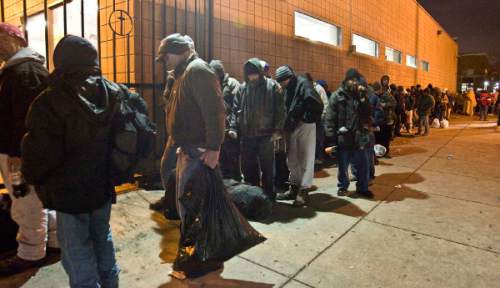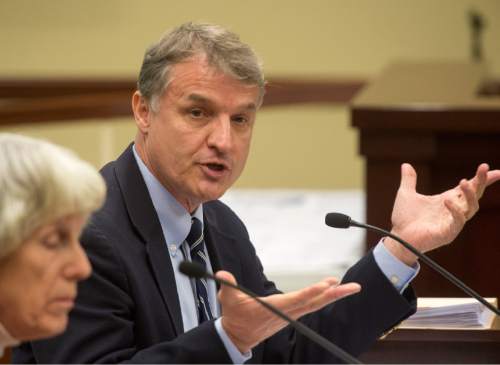This is an archived article that was published on sltrib.com in 2016, and information in the article may be outdated. It is provided only for personal research purposes and may not be reprinted.
A plan to build two new homeless shelters and a detox facility will not eliminate the need for the Road Home shelter on Rio Grande Street.
As the Salt Lake City Council and Mayor Jackie Biskupski grapple with a proposal for two new 250-bed shelters that will incorporate on-site services, the number of homeless people seeking emergency shelter continues to climb, said Matt Minkevitch, executive director for The Road Home.
Minkevitch said that statements by Salt Lake County Mayor Ben McAdams that downtown's Rio Grande Street shelter would not be necessary under the new plan are unrealistic, counterproductive and may cut into The Road Home's fundraising capabilities.
McAdams' proposal also calls for a 50-unit family-resource facility and more — but unspecified — housing.
"It does not compute," Minkevitch said Wednesday. "I'm not buying it."
The Rio Grande Street shelter near Pioneer Park has become a hub of activity for drug dealers and others who have no association with The Road Home, Minkevitch said, but fuel an assumption that homelessness is at fault.
Developers and Pioneer Park-area businesses say the scene around the shelter is dangerous and out of control. Some have pushed for its relocation.
McAdams downplayed differences in a statement late Wednesday afternoon.
"We're working together in unprecedented ways to address the public safety crisis in the Rio Grande neighborhood. Residents, families and neighbors deserve better outcomes than we've seen to date," McAdams said. "The Road Home can be an important part of the solution as we move away from business as usual towards facilities and systems that result in minimizing homelessness and safe homes and neighborhoods for everyone."
Nonetheless, when the two proposed shelters are built, The Road Home still will be essential for emergency housing and other services, Minkevitch said, including "supportive housing" and "rapid rehousing."
Between its Midvale family shelter and the facility on Rio Grande Street, The Road Home serves about 1,200 people a day. It assists another 1,700 with various housing programs.
Minkevitch noted that homelessness is growing in all demographic groups due to a lack of affordable housing and is exacerbated by low wages.
"We've been concerned about the demand curve going up sharply among every demographic," he said.
After more than 18 months of discussion between the county's Collective Impact initiative and the city's commission on siting new homeless shelters, City Council members remain frustrated and fear that 250-bed shelters are too big and could harm neighborhoods. Biskupski has yet to make public any potential shelter sites.
But the discussion surrounding new shelters and state funding for new facilities and increased services may hurt The Road Home's ability to raise funds, Minkevitch said.
September has been "soft" in fundraising. The Road Home hopes to muster $4.2 million in private donations as part of its $15 million annual budget.
Earlier this year, the Legislature set aside $9.4 million for new shelters and services. Homeless advocates hope for similar funding in the next two legislative sessions. But that may be contingent on progress of siting proposed shelters. That is why Biskupski and McAdams are pushing for resolution on the site-selection process that is now hung up on size.
But the City Council, feeling largely left out of the ongoing discussion, is seeking more than the two proposed shelters — ones that are smaller, perhaps 100 beds.
Councilwoman Erin Mendenhall said that any decision on homeless shelters should go hand in hand with programs to create new housing.
She called McAdams' proposals "best-case scenarios" that may be "idealistic."
Minkevitch agreed that housing must be the highest priority.
"We need a very clear plan on how we put that in place," he said. Curing homelessness "has to be sustainable and that is directly linked to housing."







